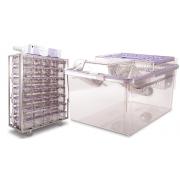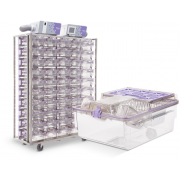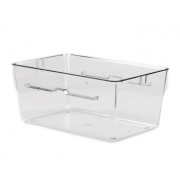Caging systems - plastic cages for laboratory animals and their exploitation
Plastic cages are made of the highest quality plastics. They can be autoclaved, are fully transparent and do not fade. The use of plastic cages has become a standard in the laboratory animal research industry.
The choice of material for a plastic cage
If you have to make the choise between polycarbonate or polysulfone cages purely for a costs point of view, you have to consider that the difference in costs between polycarbonate and polysulfone is 1:3. Therefore an investment in polysulfone can be justified if the lifetime of polysulfone is three times longer than the lifetime of polycarbonate. With a polycarbonate cage lifetime of about a 2 years, switching to polysulfone will start to be economically justified after six years. This can be considered a healthy investment. However if your lifetime of polycarbonate cages is 5 years, polysulfone will only become economical after 15 years. This is to be considered a riskfull investment due to new developments in the industry.
General guidelines about washing and sterilization of cages for laboratory animals
Polycarbonate
In the sterilization of animal cages made from polycarbonate the material may be damaged if there are alkaline cleaner residues or dried-on softened water on the surface. Consequently, any such residues must be completely removed by rinsing with fresh, alkali free water. The use of an acid rinse aid could prevent attack on the material. If soiled cages are autoclaved before cleaning, polycarbonate will be damaged.
Polycarbonate drinking bottles are generally cleaned using an acid cleaning process and finally rinsed well. Since the bottles are, as a rule, filled with water immediately after cleaning, the use of rinse aids is not required.
Polysulfone
Animal cages made from polysulfone are chemically more resistant than those made from polycarbonate and hence even allow autoclaving with soiled litter. Nevertheless, rinse cleaners should carefully be selected. Through the action of certain surfactants frequently used in cleaners and rinse aids, damage in the form of stress cracks can occur after autoclaving.
Washing of cages for laboratory animals
Use softened water. Plastic cages should be washed at a temperature of max. 55˚C. Rinsing and neutralizing cleaning agents within a short period of time can be done at around 80˚C. Strong alkaline detergents are more effective at removing organic residues. However, when they have contact
with polycarbonate will cause corrosion or hydrolysis. Therefore, the alkaline detergent should be neutralized. Acid detergents can be used when washing urine or using hard water. In most cases there is no need to neutralize them. Alkaline detergents should not be used for hand washing, especially when immersing the cages in a pre-soak container.
Autoclaving of cages for laboratory animals
Make sure that no detergent or acid rinse liquid remains on the surface; the autoclaving process will cause residue to sinter, which can cause chemical damage and loss of transparency to the plastic. Autoclaved as short as possible. The recommended minimum cycle time is 20 minutes at 121˚C. Do not stack more than 10 cages in one another. If you choose not to wash your cages before autoclaving, be aware that food and bedding debris can release harmful substances when heated. This can cause the plastic to break. If you need to autoclave the cages together with the bedding, use high-quality bedding.
Disinfection of plastic cages
Do not heat cages or bottles containing disinfectant. Check with the supplier / manufacturer which preparation is suitable for disinfecting cages.
Thermal resistance of polycarbonate and polysulfone materials. *
| Autoclaving temperature | Max. temperature of sterilization | Autoclaving | Gamma irradiation | Gas | Dry-heat | Desinfection | |
| Polycarbonate PC | 120 ˚C | 138˚C | • | • | • | - | • |
| Polysulfone PSU | 134 ˚C | 165˚C | • | • | • | - | • |
- Max. heat levels: at this temperature a solid piece of plastic will deflect under a pressure of 66psi. Therefore it is not recommended to expose animal cages to these temperatures.
- Autoclaving: during 20 minutes at 120˚C. It is highly recommended to clean and rinse the cages with softened water before autoclaving to prevent certain chemicals effecting the plastic during the autoclaving process.
- Radiation: gamma irradiation at 25 kGy
- Gas: ethylene oxide, hydrogen peroxide,fFormaldehyde
- Disinfect: formalin, ethanol, formaldehyde, benzalkonium chloride
Heat- and chemical resistance of polycarbonate and polysulfone material*
| Diluted / weak acids | Bases | Esters | Oxidant agents, strong | |
| Polycarbonate PC | Excellent | Weak | Weak | Weak |
| Polysulfone PSU | Excellent | Weak | Weak | Weak |
- Excellent: no damages after 30 days of constant exposure.
- Weak: immidiate damage may occur; severe crazing, cracking, loss of strenght, discoloration and deformation.
* The above information is a guideline only, based on generally available information.







